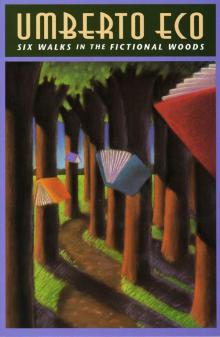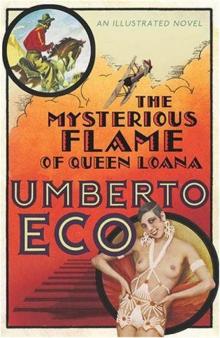- Home
- Umberto Eco
Foucault's Pendulum
Foucault's Pendulum Read online
Table of Contents
Title Page
Table of Contents
Copyright
Epigraph
Dedication
Photos
KETER
1
2
HOKHMAH
3
4
5
6
BINAH
7
8
9
10
11
12
13
14
15
16
17
18
19
20
21
22
HESED
23
24
25
26
27
28
29
30
31
32
33
GEVURAH
34
35
36
37
38
39
40
41
42
43
44
45
46
47
48
49
50
51
52
53
54
55
56
57
58
59
60
61
62
63
TIFERET
64
65
66
67
68
69
70
71
72
73
74
75
76
77
78
79
80
81
82
83
84
85
86
87
88
89
90
91
92
93
94
95
96
97
98
99
100
101
102
103
104
105
106
NEZAH
107
108
109
110
111
HOD
112
113
114
115
116
117
YESOD
118
119
MALKHUT
120
ABOUT THE AUTHOR
A signed first edition of this book has been privately
printed by The Franklin Library.
Copyright © 1988 Gruppo Editoriale Fabbri Bompiani
Sonzogno Etas S.p.A., Milano.
English translation copyright © 1989 by Harcourt, Inc.
All rights reserved. No part of this publication may be reproduced
or transmitted in any form or by any means, electronic or mechanical,
including photocopy, recording, or any information storage and retrieval
system, without permission in writing from the publisher.
Requests for permission to make copies of any part of the work
should be submitted online at www.harcourt.com/contact or mailed
to the following address: Permissions Department, Harcourt, Inc.,
6277 Sea Harbor Drive, Orlando, Florida 32887-6777.
www.HarcourtBooks.com
This is a translation of Il pendolo di Foucault.
Library of Congress Cataloging-in-Publication Data
Eco, Umberto.
[Pendolo di Foucault. English]
Foucault's pendulum/Umberto Eco;
translated from the Italian by William Weaver.
p. cm.
"A Harvest book."
I. Weaver, William, 1923– II. Title.
PQ4865.C6P4613 2007
853'.914—dc22 2006032366
ISBN 978-0-15-603297-1
Text set in Ehrhardt
Designed by Cathy Riggs
Printed in the United States of America
First Harvest edition 2007
E G I K J H F D
Only for you, children of doctrine and learning, have we written
this work. Examine this book, ponder the meaning we have
dispersed in various places and gathered again; what we have
concealed in one place we have disclosed in another, that it
may be understood by your wisdom.
—Heinrich Cornelius Agrippa von Nettesheim,
De occulta philosophia, 3, 65
Superstition brings bad luck.
—Raymond Smullyan, 5000 B.C., 1.3.8
KETER
1
That was when I saw the Pendulum.
The sphere, hanging from a long wire set into the ceiling of the choir, swayed back and forth with isochronal majesty.
I knew—but anyone could have sensed it in the magic of that serene breathing—that the period was governed by the square root of the length of the wire and by π that number which, however irrational to sublunar minds, through a higher rationality binds the circumference and diameter of all possible circles. The time it took the sphere to swing from end to end was determined by an arcane conspiracy between the most timeless of measures: the singularity of the point of suspension, the duality of the plane's dimensions, the triadic beginning of π, the secret quadratic nature of the root, and the unnumbered perfection of the circle itself.
I also knew that a magnetic device centered in the floor beneath issued its command to a cylinder hidden in the heart of the sphere, thus assuring continual motion. This device, far from interfering with the law of the Pendulum, in fact permitted its manifestation, for in a vacuum any object hanging from a weightless and unstretchable wire free of air resistance and friction will oscillate for eternity.
The copper sphere gave off pale, shifting glints as it was struck by the last rays of the sun that came through the great stained-glass windows. Were its tip to graze, as it had in the past, a layer of damp sand spread on the floor of the choir, each swing would make a light furrow, and the furrows, changing direction imperceptibly, would widen to form a breach, a groove with radial symmetry—like the outline of a mandala or pentaculum, a star, a mystic rose. No, more a tale recorded on an expanse of desert, in tracks left by countless caravans of nomads, a story of slow, millennial migrations, like those of the people of Atlantis when they left the continent of Mu and roamed, stubbornly, compactly, from Tasmania to Greenland, from Capricorn to Cancer, from Prince Edward Island to the Svalbards. The tip retraced, narrated anew in compressed time what they had done between one ice age and another, and perhaps were doing still, those couriers of the Masters. Perhaps the tip grazed Agarttha, the center of the world, as it journeyed from Samoa to Novaya Zemlya. And I sensed that a single pattern united Avalon, beyond the north wind, to the southern desert where lies the enigma of Avers Rock.
At that moment of four in the afternoon of June 23, the Pendulum was slowing at one end of its swing, then falling back lazily toward the center, regaining speed along the way, slashing confidently through the hidden parallelogram of forces that were its destiny.
Had I remained there despite the passage of the hours, to stare at that bird's head, that spear's tip, that obverse helmet, as it traced its diagonals in the void, grazing the opposing points of its astigmatic circumference, I would have fallen victim to an illusion: that the Pe
ndulum's plane of oscillation had gone full circle, had returned to its starting point in thirty-two hours, describing an ellipse that rotated around its center at a speed proportional to the sine of its latitude. What would its rotation have been had it hung instead from the dome of Solomon's Temple? Perhaps the Knights had tried it there, too. Perhaps the solution, the final meaning, would have been no different. Perhaps the abbey church of Saint-Martin-des-Champs was the true Temple. In any case, the experiment would work perfectly only at the Pole, the one place where the Pendulum, on the earth's extended axis, would complete its cycle in twenty-four hours.
But this deviation from the Law, which the Law took into account, this violation of the rule did not make the marvel any less marvelous. I knew the earth was rotating, and I with it, and Saint-Martin-des-Champs and all Paris with me, and that together we were rotating beneath the Pendulum, whose own plane never changed direction, because up there, along the infinite extrapolation of its wire beyond the choir ceiling, up toward the most distant galaxies, lay the Only Fixed Point in the universe, eternally unmoving.
So it was not so much the earth to which I addressed my gaze but the heavens, where the mystery of absolute immobility was celebrated. The Pendulum told me that, as everything moved—earth, solar system, nebulae and black holes, all the children of the great cosmic expansion—one single point stood still: a pivot, bolt, or hook around which the universe could move. And I was now taking part in that supreme experience. I, too, moved with the all, but I could see the One, the Rock, the Guarantee, the luminous mist that is not body, that has no shape, weight, quantity, or quality, that does not see or hear, that cannot be sensed, that is in no place, in no time, and is not soul, intelligence, imagination, opinion, number, order, or measure. Neither darkness nor light, neither error nor truth.
I was roused by a listless exchange between a boy who wore glasses and a girl who unfortunately did not.
"It's Foucault's Pendulum," he was saying. "First tried out in a cellar in 1851, then shown at the Observatoire, and later under the dome of the Pantheon with a wire sixty-seven meters long and a sphere weighing twenty-eight kilos. Since 1855 it's been here, in a smaller version, hanging from that hole in the middle of the rib."
"What docs it do? Just hang there?"
"It proves the rotation of the earth. Since the point of suspension doesn't move..."
"Why doesn't it move?"
"Well, because a point ... the central point, I mean, the one right in the middle of all the points you see ... it's a geometric point; you can't see it because it has no dimension, and if something has no dimension, it can't move, not right or left, not up or down. So it doesn't rotate with the earth. You understand? It can't even rotate around itself. There is no 'itself.'"
"But the earth turns."
"The earth turns, but the point doesn't. That's how it is. Just take my word for it."
"I guess it's the Pendulum's business."
Idiot. Above her head was the only stable place in the cosmos, the only refuge from the damnation of the panta rei, and she guessed it was the Pendulum's business, not hers. A moment later the couple went off—he, trained on some textbook that had blunted his capacity for wonder, she, inert and insensitive to the thrill of the infinite, both oblivious of the awesomeness of their encounter—their first and last encounter—with the One, the Ein-Sof, the Ineffable. How could you fail to kneel down before this altar of certitude?
I watched with reverence and fear. In that instant I was convinced that Jacopo Belbo was right. What he told me about the Pendulum I had attributed to esthetic raving, to the shapeless cancer taking gradual shape in his soul, transforming the game into reality without his realizing it. But if he was right about the Pendulum, perhaps all the rest was true as well: the Plan, the Universal Plot. And in that case I had been right to come here, on the eve of the summer solstice. Jacopo Belbo was not crazy; he had simply, through his game, hit upon the truth.
But the fact is that it doesn't take long for the experience of the Numinous to unhinge the mind.
I tried then to shift my gaze. I followed the curve that rose from the capitals of the semicircle of columns and ran along the ribs of the vault toward the key, mirroring the mystery of the ogive, that supreme static hypocrisy which rests on an absence, making the columns believe that they are thrusting the great ribs upward and the ribs believe that they are holding the columns down, the vault being both all and nothing, at once cause and effect. But I realized that to neglect the Pendulum that hung from the vault while admiring the vault itself was like becoming drunk at the stream instead of drinking at the source.
The choir of Saint-Martin-des-Champs existed only so that, by virtue of the Law, the Pendulum could exist; and the Pendulum existed so that the choir could exist. You cannot escape one infinite, I told myself, by fleeing to another; you cannot escape the revelation of the identical by taking refuge in the illusion of the multiple.
***
Still unable to take my eyes from the key of the vault, I retreated, step by step, for I had learned the path by heart in the few minutes I had been there. Great metal tortoises filed past me on either side, imposing enough to signal their presence at the corner of my eyes. I fell back along the nave toward the front entrance, and again those menacing prehistoric birds of wire and rotting canvas loomed over me, evil dragonflies that some secret power had hung from the ceiling of the nave. I saw them as sapiential metaphors, far more meaningful than their didactic pretext. A swarm of Jurassic insects and reptiles, allegory of the long terrestrial migrations the Pendulum was tracing, aimed at me like angry archons with their long archeopterix-beaks: the planes of Bréguet, Blériot, Esnault, and the helicopter of Dufaux.
To enter the Conservatoire des Arts et Métiers in Paris, you first cross an eighteenth-century courtyard and step into an old abbey church, now part of a later complex, but originally part of a priory. You enter and arc stunned by a conspiracy in which the sublime universe of heavenly ogives and the chthonian world of gas guzzlers are juxtaposed.
On the floor stretches a line of vehicles: bicycles, horseless carriages, automobiles; from the ceiling hang planes. Some of the objects are intact, though peeling and corroded by time, and in the ambiguous mix of natural and electric light they seem covered by a patina, an old violin's varnish. Others are only skeletons or chassis, rods and cranks that threaten indescribable tortures. You picture yourself chained to a rack, something digging into your flesh until you confess.
Beyond this sequence of antique machines—once mobile, now immobile, their souls rusted, mere specimens of the technological pride that is so keen to display them to the reverence of visitors—stands the choir, guarded on the left by a scale model of the Statue of Liberty Bartholdi designed for another world, and on the right by a statue of Pascal. Here the swaying Pendulum is flanked by the nightmare of a deranged entomologist—chelae, mandibles, antennae, proglottides, and wings—a cemetery of mechanical corpses that look as if they might all start working again at any moment—magnetos, monophase transformers, turbines, converters, steam engines, dynamos. In the rear, in the ambulatory beyond the Pendulum, rest Assyrian idols, and Chaldean, Carthaginian, great Baals whose bellies, long ago, glowed red-hot, and Nuremberg Maidens whose hearts still bristle with naked nails: these were once airplane engines. Now they form a horrible garland of simulacra that lie in adoration of the Pendulum; it is as if the progeny of Reason and the Enlightenment had been condemned to stand guard forever over the ultimate symbol of Tradition and Wisdom.
The bored tourists who pay their nine francs at the desk or are admitted free on Sundays may believe that elderly nineteenth-century gentlemen—beards yellowed by nicotine, collars rumpled and greasy, black cravats and frock coats smelling of snuff, fingers stained with acid, their minds acid with professional jealousy, farcical ghosts who called one another cher maitre—placed these exhibits here out of a virtuous desire to educate and amuse the bourgeois and the radical taxpayers, and to celebr
ate the magnificent march of progress. But no: Saint-Martin-des-Champs had been conceived first as a priory and only later as a revolutionary museum and compendium of arcane knowledge. The planes, those self-propelled machines, those electromagnetic skeletons, were carrying on a dialog whose script still escaped me.
The catalog hypocritically informed me that this worthy undertaking had been conceived by the gentlemen of the Convention, who wanted to offer the masses an accessible shrine of all the arts and trades. But how could I believe that when the words used to describe the project were the very same Francis Bacon had used to describe the House of Solomon in his New Atlantis?
Was it possible that only I—along with Jacopo Belbo and Diotallevi—had guessed the truth? Perhaps I would have my answer that night. I had to find a way to remain in the museum past closing, and wait here for midnight.
How would They get in? I had no idea. Some passageway in the network of the Paris sewers might connect the museum to another point in the city, perhaps near Porte St.-Denis. But I was certain that if I left, I would not be able to find that route back in. I had to hide somewhere in the building.
I tried to shake off the spell of the place and look at the nave with cold eyes. It was not an epiphany now I was seeking, but information. I imagined that in the other halls it would be difficult to escape the notice of the guards, who made the rounds at closing time, checking to see that no thief was lurking somewhere. The nave, however, crammed with vehicles, was the ideal place to settle in for the night as a passenger: a live man hiding inside a lifeless vehicle. We had played too many games for me not to try this one, too.
Take heart, I said to myself: don't think of Wisdom now; ask the help of Science.
2
Wee haue divers curious Clocks; And other like Motions of Return.... Wee haue also Houses of Deceits of the Senses, where we represent all manner of Feats of Juggling, False Apparitions, Impostures, and Illusions.... These are (my sonne) the Riches of Salomon's House.
—Francis Bacon, The New Atlantis, ed. Rawley, London, 1627, pp. 41–42

 Baudolino
Baudolino The Name of the Rose
The Name of the Rose Chronicles of a Liquid Society
Chronicles of a Liquid Society Inventing the Enemy: Essays
Inventing the Enemy: Essays Foucault's Pendulum
Foucault's Pendulum How to Travel With a Salmon & Other Essays
How to Travel With a Salmon & Other Essays Numero zero
Numero zero The Island of the Day Before
The Island of the Day Before UMBERTO ECO : THE PRAGUE CEMETERY
UMBERTO ECO : THE PRAGUE CEMETERY On the Shoulders of Giants
On the Shoulders of Giants Misreadings
Misreadings Six Walks in the Fictional Woods
Six Walks in the Fictional Woods The Mysterious Flame Of Queen Loana
The Mysterious Flame Of Queen Loana The Prague Cemetery
The Prague Cemetery On Literature
On Literature Lost structure
Lost structure